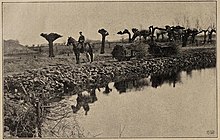Feldbahn of the orchard Wilhelm de Joncheere
| Wilhelm de Joncheere orchard | |
|---|---|
|
Light railway operation in the vegetable nursery, 1909
| |
| Route length: | 2.8 km |
| Gauge : | 500 mm ( narrow gauge ) |
The field railway of the Wilhelm de Joncheere orchard in Kleve on the Lower Rhine was a 2.8 km long field railway used for agricultural purposes around 1909 for a gardening and plantation company on the German-Dutch border.
history
In order to transport plants, fertilizer, compost and the harvest, the Wilhelm de Joncheere orchard at the Wasserburg in Kleve operated a field railway with one produced by the Dortmund factory of Leipziger & Co. from Cologne, which specializes in field and industrial railways 500 mm track. In the plantation, which was 2.72 km long, the manure transport caused particular difficulties.
Because of the great length of the plantations, the construction of a driveway, apart from the associated loss of usable cultivated land, would have resulted in unusually high costs. Instead, a 2,800 m long field railway with a fixed track was laid. In order to get from this with the materials to be transported to the individual quarters, climbing switches were placed at the appropriate points and connected to these 2½ m long track bays to continue the railway on flying track .
A worker could comfortably carry this track yoke, so that a branch line of 200 m length and more could be laid in the relevant quarter in a short time. With the trolleys, on which the head gardener of the orchard, A. Haindl, had boxes mounted or with tipping lorries, fertilizer, compost etc. could be emptied on both sides of the side track and distributed accordingly. In this way it was possible to get to all parts of the plantation without much loss of time and with considerable savings in wages. The whole plantation was so planted that the side tracks could be placed anywhere between the rows of plants. With the help of this field railway, even in bad weather in autumn and spring, large areas were fertilized quickly. Two or three men could not carry what a working girl on the dump truck could quickly push over the tracks. When it came to large, heavy transports, several tipping wagons were coupled together and led by a horse or donkey.
Cost use Bill
The system was not cheap to procure, but it paid for itself quickly. The annual demand for fertilizer was over 1000 loads of manure delivered from the city, whereby 50 pfennigs per load or 500 marks per year could be saved in transport costs because the manure storage area was closer to the city.
The procurement costs of the light railroad were as follows:
| product | Price per piece | price |
|---|---|---|
| 4,000 m of track | 2 marks each | 8,000 marks |
| 8 dump trucks | at 70 marks | 560 marks |
| 8 boxes for this car | 40 marks each | 320 marks |
| Turnouts and turntables | 500 marks | |
| 1 water cart | 200 marks | |
| total | 9,580 marks |
This sum, rounded up to 10,000 marks and with 5% interest, resulted in 500 marks, i.e. H. a sum that the company saved by saving on fertilizer wages alone. However, the considerable savings in working time and thus in labor and wages were also to be taken into account, which at least compensated for the depreciation to be carried out on the plant.
The field railway also enabled the quick transport of tall trunks from the tree nursery to the packing shed and the harvested strawberries to the cellar. The strawberries were loaded directly next to the beds and transported from there to the cellar, avoiding shaking. The vegetable nursery was also provided with a track system that made it possible to drive to every hotbed box .
There were turntables between the individual box systems. As a result, cold hotbed boxes could be quickly emptied and refilled. The driving vegetables were loaded from the boxes directly onto the wagons and driven to the packing shed or to the cellar for cleaning.
The light rail system made it possible to operate the large area with relatively few workers and few horses. What used to be transported by a horse could be pushed over the tracks by a field train, which freed up the horse's power to do chopping in the plantation. Although the light railroad was rarely used in summer, its operation enabled considerable savings in autumn and spring.
Individual evidence
- ↑ Gardeners Labor and Real Estate Market , Berlin, July 20, 1926, No. 58.
- ↑ a b A. Haindl: Use of field railways in gardening and plantation operations. In: The garden world. Volume 13, No. 29, July 17, 1909.
Coordinates: 51 ° 48 ′ 16.7 " N , 6 ° 7 ′ 53.1" E




